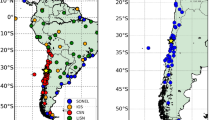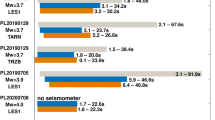Abstract
High-frequency geodesy is here intended as the capability of retrieving information relevant to geodesy and geophysics at high frequency through geodetic measurements and methodologies. In particular, this short review work focuses on two aspects: fast ground motions, as those due to earthquakes, and fast ionospheric total electron content (TEC) disturbances, as those caused by tsunamis. This information can be retrieved, even in real time, from Global Navigation Satellite System observations collected at high rate (equal or higher than 1 Hz), and can significantly support geohazard understanding contributing in seismic moment estimation and tsunami early warning. Here, the real-time possibilities of the new variometric approach for high-frequency geodesy are summarized: the fundamental idea is to directly focus on the quantities of interest, which are “variations” (of positions, of ionospheric TEC) and can be properly estimated in real time. The work moves “from ground to ionosphere”: with respect to the ground, the more consolidated application of the variometric approach to GNSS seismology (VADASE) is presented, up to the latest developments; with respect to the ionosphere, the brand new application named VARION for TEC disturbances computation is described, and the first results of the application to the Illapel, Chile earthquake (USGS \(M=8.3\), 16 September 2015, 22:54:32 UTC) are shown.














Similar content being viewed by others
References
Artru J, Ducic V, Kanamori H, Lognonn P, Murakami M (2005) Ionospheric detection of gravity waves induced by tsunamis. Geophys J Int 20:840–848. https://doi.org/10.1111/j.1365-246X.2005.02552.x
Baarda W (1968) A testing procedure for use in geodetic networks. Publ Geod 2(5), Netherlands Geodetic Commission, Delft, The Netherlands. ISBN-13: 978 90 6132 209 2, ISBN 10: 90 6132 209 X
Benedetti E, Branzanti M, Biagi L, Colosimo G, Mazzoni A, Crespi M (2014) Global navigation satellite systems seismology for the 2012 Mw 6.1 Emilia earthquake: exploiting the VADASE algorithm. Seismol Res Lett 85(3):649–656. https://doi.org/10.1785/0220130094
Benedetti E, Branzanti M, Colosimo G, Mazzoni A, Crespi M (2016) VADASE: state of the art and new developments of a third way to GNSS seismology. Int Assoc Geod Symp 142:59–66. https://doi.org/10.1007/1345_2015_7
Benedetti E, Dermanis A, Crespi M (2017) On the feasibility to integrate low-cost MEMS accelerometers and GNSS receivers. Adv Space Res 59(11):2764–2778. https://doi.org/10.1016/j.asr.2017.02.005
Biagi L, Caldera S (2013) An efficient Leave One Block Out approach to identify outliers. J Appl Geod 7(1):11–19. https://doi.org/10.1515/jag-2012-0030
Bishop G, Walsh D, Daly P, Mazzella A, Holland E (1994) Analysis of the temporal stability of GPS and GLONASS group delay correction terms seen in various sets of ionospheric delay data. In: Proceedings of the 7th international technical meeting of the satellite division of the institute of navigation (ION GPS 1994), pp 1653–1661
Blewitt G, Kreemer C, Hammond WC, Plag HP, Stein S, Okal E (2006) Rapid determination of earthquake magnitude using GPS for tsunami warning systems. Geophys Res Lett 33:11. https://doi.org/10.1029/2006GL026145
Bock Y, Genrich JF (2006) Instantaneous geodetic positioning with 10–50 Hz GPS measurements: noise characteristics and implications for monitoring networks. J Geophys Res 111:3. https://doi.org/10.1029/2005JB003617
Bock Y, Agnew DC, Fang P, Genrich JE, Hager BH, Herring TA, Hudnut KW, King RW, Larsen S, Minster JB, Stark K, Wdowinski S, Wyatt EW (1993) Detection of crustal deformation from the landers earthquake sequence using continuous geodetic measurements. Nature 361:337–340. https://doi.org/10.1038/361337a0
Bock Y, Nikolaidis RM, de Jonge PJ, Bevis M (2000) Instantaneous geodetic positioning at medium distances with the global positioning system. J Geophys Res 105:28223. https://doi.org/10.1029/2000JB900268
Branzanti M, Colosimo G, Crespi M, Mazzoni A (2013) GPS near-real-time coseismic displacements for the great Tohoku-oki earthquake. IEEE Geosci Remote Sens Lett 10:372–376. https://doi.org/10.1109/LGRS.2012.2207704
Branzanti M, Benedetti E, Colosimo G, Mazzoni A, Crespi M (2014) Real-time monitoring of fast displacements with VADASE: new applications and challenges with Galileo. In: ENC-GNSS 2014 PROCEEDINGS. Rotterdam (the Netherlands)
Brovelli MA, Crespi M, Fratarcangeli F, Giannone F, Realini E (2008) Accuracy assessment of high resolution satellite imagery orientation by leave-one-out method. ISPRS J Photogramm Remote Sens 63(4):427–440. https://doi.org/10.1016/j.isprsjprs.2008.01.006
Brunini C, Meza A, Bosch W (2005) Temporal and spatial variability of the bias between topex- and GPS-derived total electron content. J Geod 79:175. https://doi.org/10.1007/s00190-005-0448-z
Cheloni D, De Novellis V, Albano M, Antonioli A, Anzidei M, Atzori S, Avallone A, Bignami C, Bonano M, Calcaterra S, Castaldo R, Casu F, Cecere G, De Luca C, Devoti R, Di Bucci D, Esposito A, Galvani A, Gambino P, Giuliani R, Lanari R, Manunta M, Manzo M, Mattone M, Montuori A, Pepe A, Pepe S, Pezzo G, Pietrantonio G, Polcari M, Riguzzi F, Salvi S, Sepe V, Serpelloni E, Solaro G, Stramondo S, Tizzani P, Tolomei C, Trasatti E, Valerio E, Zinno I, Doglioni C (2017) Geodetic model of the 2016 Central Italy earthquake sequence inferred from InSAR and GPS data. Geophys Res Lett 44:6778–6787. https://doi.org/10.1002/2017GL073580
Ciraolo L, Azpilicueta F, Brunini C, Meza A, Radicella SM (2007) Calibration errors on experimental slant total electron content (TEC) determined with GPS. J Geod 81:111. https://doi.org/10.1007/s00190-006-0093-1
Colosimo G, Crespi M, Mazzoni A (2011) Real-time GPS seismology with a stand-alone receiver: a preliminary feasibility demonstration. J Geophys Res 116(B11):302. https://doi.org/10.1029/2010JB007941
Crespi M, Mazzoni A, Colosimo G (2015) Global and local reference frames. Rend Fis Acc Lincei 26(18):25–31. https://doi.org/10.1007/s12210-015-0435-0
Daniels FB (1952) Acoustic energy generated by ocean waves. J Acoust Soc Am 24:83. https://doi.org/10.1121/1.1906855
Galvan DA, Komjathy A, Hickey MP, Stephens P, Snively J, Song YT, Butala MD, Mannucci AJ (2012) Ionospheric signatures of tohoku-oki tsunami of march 11, 2011: model comparisons near the epicenter. Radio Sci 47:RS4003. https://doi.org/10.1029/2012RS005023
Hines CO (1960) Internal atmospheric gravity waves at ionospheric heights. Can J Phys 38:1441–1481. https://doi.org/10.1139/p60-150
Hines CO (1972) Gravity waves in the atmosphere. Nature 239:7378. https://doi.org/10.1038/239073a0
Hung HK, Rau RJ (2011) Tohoku earthquake: observations of Taiwans dense high-rate GPS network. J Geophys Res 118(1):332–345. https://doi.org/10.1029/2012JB009689
IGSMAIL-6358 (2011) Magnitude 8.8 earthquake offshore of Japan-preliminary computation of GPS displacement waveforms at MIZU and USUD. https://lists.igs.org/pipermail/igsmail/2011/000192.html
Klobuchar JA (1987) Ionospheric time-delay algorithm for single frequency GPS users. IEEE Trans Aero Electron Syst 23:325–331. https://doi.org/10.1109/TAES.1987.310829
Komjathy A (2017) Sensing our planet—NASAs Earth Science Research Features 2017. https://cdn:earthdata:nasa:gov/conduit/upload/7268/NASASOP2017:pdf
Komjathy A, Sparks L, Wilson BD, Mannucci AJ (2005) Automated daily processing of more than 1000 ground-based GPS receivers for studying intense ionospheric storms. Radio Sci 40:RS6006. https://doi.org/10.1029/2005RS003279
Kouba J (2003) Measuring seismic waves induced by large earthquakes with GPS. Stud Geophys et Geod 47:741–755. https://doi.org/10.1023/A:1026390618355
Langbein J, Bock Y (2004) High-rate real-time GPS network at parkfield: utility for detecting fault slip and seismic displacements. Geophys Res Lett 31:L15. https://doi.org/10.1029/2003GL019408
Larson K (2009) GPS seismology. J Geod 83:227–233. https://doi.org/10.1007/s00190-008-0233-x
Larson K, Bilich A, Axelrad P (2007) Improving the precision of high-rate GPS. J Geophys Res 112:B5. https://doi.org/10.1029/2006JB004367
Mannucci AJ et al (2004) GPS-based remote sensing of the geospace environment: horizontal and vertical structure of the ionosphere and plasmasphere. Proc SPIE Int Soc Opt Eng 5660:113. https://doi.org/10.1117/12.580048
Mannucci AJ, Wilson BD, Yuan DN, Ho CH, Lindqwister UJ, Runge TF (1998) A global mapping technique for GPS derived ionospheric total electron content measurements. Radio Sci 33:565582. https://doi.org/10.1029/97RS02707
Ohta Y, Kobayashi T, Tsushima H, Miura S, Hino R, Takasu T, Fujimoto H, Iinuma T, Tachibana K, Demachi T, Sato T, Ohzono M, Umino N (2012) Quasi real-time fault model estimation for near-field tsunami forecasting based on RTK-GPS analysis: application to the 2011 Tohokuoki earthquake (Mw 9.0). J Geophys Res 117(2):B02311. https://doi.org/10.1029/2011JB008750
Rolland LM, Occhipinti G, Lognonn P, Loevenbruck A (2010) Ionospheric gravity waves detected offshore Hawaii after tsunamis. Geophys Res Lett 37:L17101. https://doi.org/10.1029/2010GL044479
Sansò F (1996) La verifica di ipotesi. CittStudiEdizioni ISBN 88-251-7166-8
Sardon E, Rius A, Zarraoa N (1994) Estimation of the transmitter and receiver differential biases and the ionospheric total electron content from global positioning system observations. Radio Sci 29:577–586. https://doi.org/10.1029/94RS00449
Savastano G, Komjathy A, Verkhoglyadova O, Mazzoni A, Crespi M, Wei Y, Mannucci A (2017) Real-time detection of Tsunami ionospheric disturbances with a stand-alone GNSS receiver: a preliminary feasibility demonstration. Sci Rep 7:46607. https://doi.org/10.1038/srep46607
Teunissen PJG (2000) Testing theory; an introduction. Delft University Pressy. ISBN:90-407-1975-6
Teunissen PJG, Khodabandeh A (2015) Review and principles of PPP–RTK methods. J Geod 89:217. https://doi.org/10.1007/s00190-014-0771-3
Xu P, Shi C, Fang R, Liu J, Niu X, Zhang Q, Yanagidani T (2012) High-rate precise point positioning (PPP) to measure seismic wave motions: an experimental comparison of GPS PPP with inertial measurement units. J Geod 87(4):361–372. https://doi.org/10.1007/s00190-012-0606-z
Acknowledgements
VADASE is subject of an international pending patent, generously supported by the University of Rome “La Sapienza” and by its Start-Up Kuaterion srl. VADASE was awarded the DLR (German Aerospace Agency) Special Topic Prize and the Audience Award at the European Satellite Navigation Competition 2010, was partially developed thanks to 1-year cooperation with DLR Institute for Communications and Navigation at Oberpfaffenhofen (Germany), and was included in the Success Stories of European Satellite Navigation Competition 2012. VARION was tested at NASA Jet Propulsion Laboratory thank to an ISSNAF fellowship granted to Giorgio Savastano, also supported by a PhD fellowship of the University of Rome “La Sapienza”.
Author information
Authors and Affiliations
Corresponding author
Rights and permissions
About this article
Cite this article
Fratarcangeli, F., Ravanelli, M., Mazzoni, A. et al. The variometric approach to real-time high-frequency geodesy. Rend. Fis. Acc. Lincei 29 (Suppl 1), 95–108 (2018). https://doi.org/10.1007/s12210-018-0708-5
Received:
Accepted:
Published:
Issue Date:
DOI: https://doi.org/10.1007/s12210-018-0708-5




